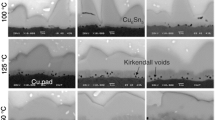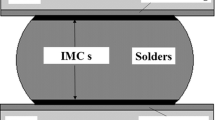Abstract
Lead-free solders were never an industry choice until government legislation, their wide spread use is still in its infancy due to long term reliability issues. A specific SAC (Tin-Silver-Copper) family of solder alloys has emerged as the favourite to offer technical advantages as well as meeting those legislative requirements. This paper investigates accelerated life behaviour of lead-free solder joints and printed circuit boards using thermal and electrical stress cycling. The aim is to understand the degradation of these materials in a practical operating environment. Whilst corrosion and debris deposits have been found, no significant evidence has been obtained for tin whiskering. EDX analysis has shown the presence of high concentrations of elements considered to arise from the packaging material. Thermal cycling tests have presented an aggressive environment to the samples and the effect on them has been supported by microscopic and macroscopic observations of debris and corrosion. The electrical behaviour, i.e., the joint resistance, has not however, significantly degraded.












Similar content being viewed by others
References
M. Wickham, L. Zou, M. Dusek, C. Hunt, Measuring the reliability of electronics assemblies during the transition period to lead-free soldering, NPL report, DEPC MPR 030, August 2005
T. Fang, M. Osterman, M. Pecht, A tin whisker risk assessment algorithm, 38th International Symposium on Microelectronics, Reliability I (Issues in Packaging), pp. 61–65, Philadelphia, PA, September 25–29, 2005
S. Ganesan, J. Wu, M. Pecht, Assessment of long-term reliability in lead-free assemblies, International Conference on Asian Green Electronics, Session 3, pp. 140–155, Shang Hai, China, March 15–18, 2005
M. Wickham, L. Zou, M. Dusek, C. Hunt, Measuring the impact of component solderability on lead-free solder joint reliability, NPL report, DEPC MPR 038, November 2005
K. Seelig, A study of lead-free solder alloys, Association for automatic identification and mobility, AIM Inc., Vol. 1, Issue 1, September 1995
A few examples: http://www.turi.org/industry/alternatives_research/new_england_lead_free_electronics_consortium, http://www.national.com/analog/packaging/lf_consortia, http://www.xs4all.nl/~tersted/PDF_files/Loctite/smta.pdf. Accessed 16 Nov. 2009
M.T. McCormack, Y. Degani, H.S. Chen, W.R. Gesick, Lower-melting-point solder alloy for surface mounts, JOM, a publication of The Minerals, Metals & Materials Society, 48, (5) (1996), pp. 54–56
M. Dusek, C. Hunt, The measurement of creep rates and stress relaxation for micro sized lead-free solder joints, NPL report, DEPC MPR 021, April 2005
Y.G. Lee, J.G. Duh, Characterizing the formation and growth of intermetallic compounds in the solder joint, J. Mater. Sci. 33, 5569–5572 (1998)
J. Glazer, Microstructure and mechanical properties of Pb-free solder alloys for low-cost electronic assembly: a review. J. Electron. Mater. 23(8), 693–700 (1994)
H. Mavoori, J. Chin, S. Vaynman, B. Moran, L. Keer, M. Fine, Creep, stress relaxation, and plastic deformation in Sn-Ag and Sn-Zn eutectic solders. J. Electron. Mater. 26(7), 783–790 (1997)
D. Yu, W. Jillek, E. Schmitt, Electrochemical migration of lead free solder joints. J. Mater. Sci. Mater. Electron. 17, No. 3, March 2006, pp. 229–241
K. Sweatman, Fact and fiction in lead-free soldering, DKL Metals. Global SMT & Packaging, April 2006, http://www.dklmetals.co.uk/PDF%20Files/Factorfiction.pdf, last visited on 17 May 2010
C.E. Ho, S.C. Yang, C.R. Kao, Interfacial reaction issues for lead-free electronic solders. J. Mater. Sci. Mater. Electron. 8, No. 1–3, March 2007, pp. 155–174
Y. Kariya, M. Otsuka, J. Electron. Mater. 27, No 11, p. 1229–1235 (1998)
W.J. Plumbridge, C.R. Gagg, Effects of strain rate and temperature on the stress-strain response of solder alloys. J. Mater. Sci. Mater. Electron. No. 10, 461–468 (1999)
W. Ren, M. Lu, S. Liu, D. Shangguan, Themal mechanical property testing of new lead-free solder joints. Solder. Surf. Mount Technol. 9, No. 3, October 1997, pp. 37–40
EIA/JEDEC Standard: JESD201 Environmental acceptance requirements for tin whisker susceptibility of tin and tin alloy surface finishes, March 2006
M. Warwick, Implementing lead free soldering—European consortium research, SMTA. J. SMTA, 12, Issue 4, October 1999, pp. 1–12
EIA/JEDEC Standard: JESD22-A121 Measuring whisker growth on tin and tin alloy surface finish, May 2005
EIA/JEDEC Standard: JESD22-A105C Power and temperature cycling
JEDEC, JESD22A121, Test method for measuring whisker growth on tin and tin alloy surface finishes, May 2005 (based on recommendations of the iNEMI Tin Whisker Accelerated Test Project)
K. Seelig, A study of lead-free solder alloys, AIM Inc, September 1995
K.S. Hansen, M.S. Jellesen, P. Møller, P.J.S. Westermann, R. Ambat, Effect of solder flux residues on corrosion of electronics, downloaded on 9th April 2010 at UTC from IEEE Xplore
S.B. Lyon, G.E. Thompson, B. Johnson, Materials evaluation using wet-dry mixed salt-spray tests, ASTM International symposium on corrosion testing of Aluminium alloys, San Francisco, California, 12 p, 1990
R. Veale, Reliability of PCB Alternate Surface Finishes in a Harsh Industrial Environment (SMTA International, Chicago, IL, 2005)
R. Schueller, Creep Corrosion on Lead-Free Printed Circuit Boards in High Sulfur Environments (SMTA International Proceedings, Orlando, FL, 2007)
P. Mazurkiewicz, Accelerated corrosion of printed circuit boards due to high levels of reduced sulfur gasses in industrial environments, Proceedings of the 32nd International Symposium for Testing and Failure Analysis, November 12–16th, 2006
C.E. Ho, S.C. Yang, C.R. Kao, Interfacial reaction issues for lead-free electronic solders. J. Mater. Sci. Mater. Electron. 18, Numbers 1–3, March, 2007, pp. 155–174
M. Wickham, L. Zou, M. Dusek, C. Hunt, Effect of voiding on lead-free reliability, NPL report, DEPC MPR 033, April 2005
J. Smetana, Theory of tin whisker growth: the end game. IEEE Trans. Electron. Packag. Manuf. 30, No. 1, January 2007
M. Dittes, P. Oberndorff, P. Crema, V. Schroeder, Tin whisker formation in thermal cycling conditions. Electronic Packaging Technology Conference, 2006, pp. 183–188
A. Rahn, The basics of soldering, Wiley, 1993, p 1
J.H.L. Pang, K.H. Prakash, T.H. Low, Isothermal and thermal cycling ageing on IMC growth rate in Pb-free and Pb-based solder interfaces, 9th Intersociety Conference on Thermal and Thermomechanical Phenomena in Electronic Systems, Las Vegas, NV, 01–04 June 4, 2004
J. Guo-Kui, W. Xi-Cheng, S. Peng, L. Johan, The comparison studies on growth kinetics of IMC of Cu/Sn3.0Ag0.5Cu (Sn0.4Co0.7Cu)/Cu joints during isothermal aging and their tensile strengths. Solder. Surf. Mount Technol. 20/3 (2008) 4–10
C.E. Ho, S.C. Yang, C.R. Kao, Interfacial reaction issues for lead-free electronic solders. J. Mater. Sci. Mater. Electron. 18, Numbers 1–3, March 2007, pp. 155–174
Y. Kariya, C. Gagg, W.J. Plumbridge, Tin pest in lead-free solders. Solder. Surf. Mount Technol. 13(1), 39–40 (2001)
D. Yu, W. Jillek, E. Schmitt, Electrochemical migration of Sn-Pb and lead free solder alloys under distilled water, J. Mater. Sci. Mater. Electron. 17, Number 3, March 2006, pp. 219–227(9)
C.E. Ho, S.C. Yang, C.R. Kao, Interfacial reaction issues for lead-free electronic solders. J. Mater. Sci. Mater. Electron. 18, Numbers 1–3, March 2007, pp. 155–174
Acknowledgments
This work forms the foundation for the recently initiated “Pbless” research consortium. The authors would like to thank Chris Thompson for conducting some of the experimental tests and Professor F. C. Walsh and Dr. J. Wharton for their advice on the corrosion aspects of the work.
Author information
Authors and Affiliations
Corresponding author
Rights and permissions
About this article
Cite this article
Moshrefi-Torbati, M., Swingler, J. Reliability of printed circuit boards containing lead-free solder in aggressive environments. J Mater Sci: Mater Electron 22, 400–411 (2011). https://doi.org/10.1007/s10854-010-0150-7
Received:
Accepted:
Published:
Issue Date:
DOI: https://doi.org/10.1007/s10854-010-0150-7




